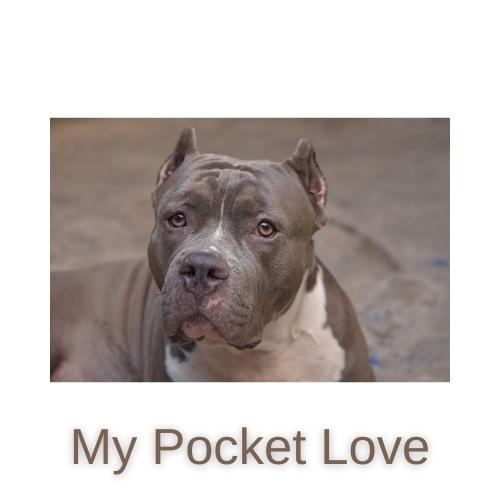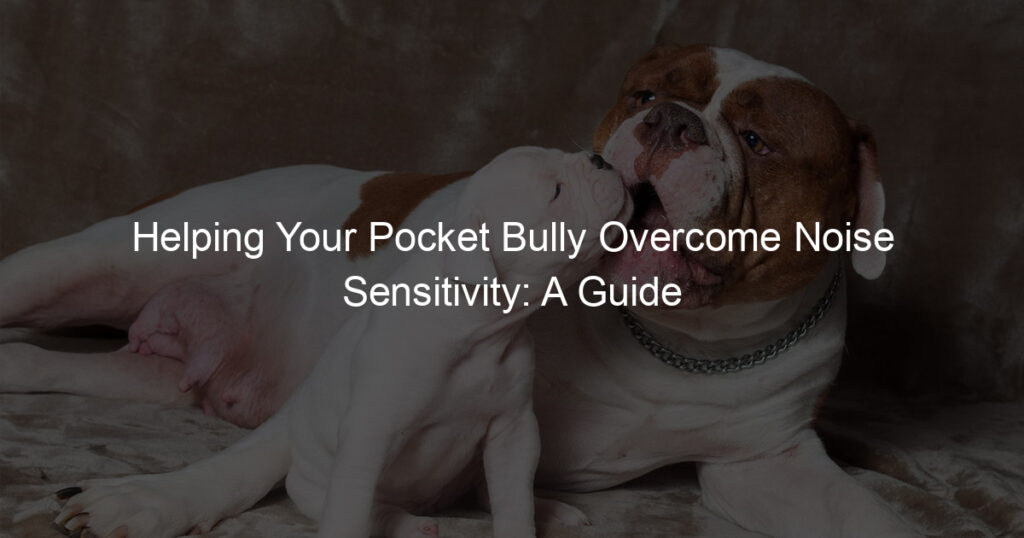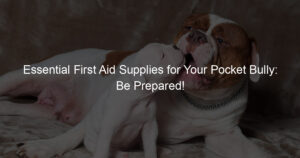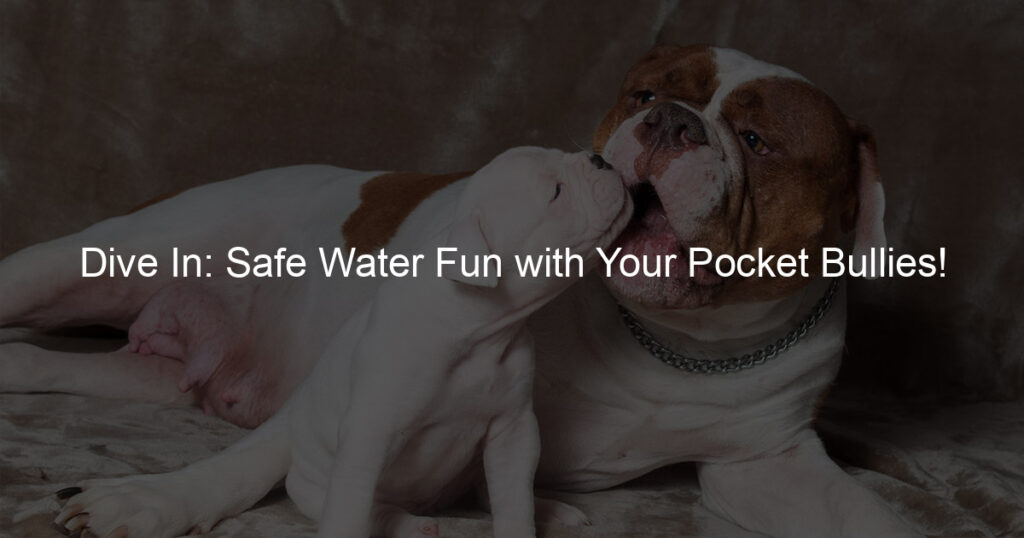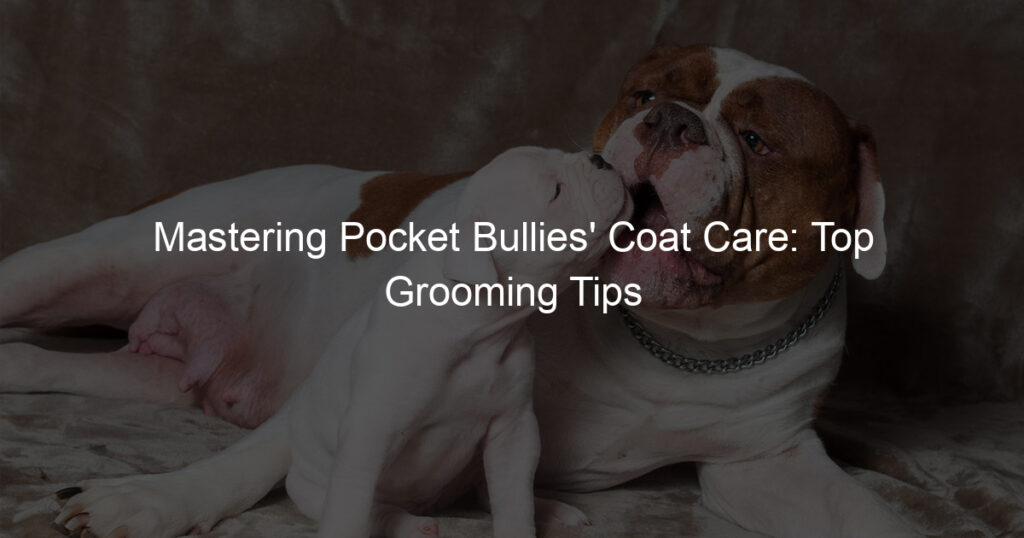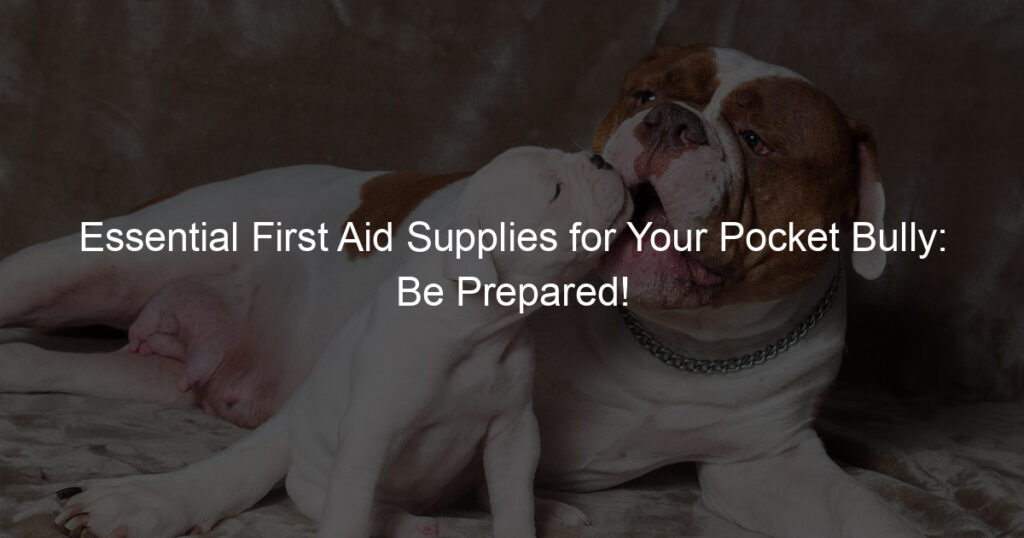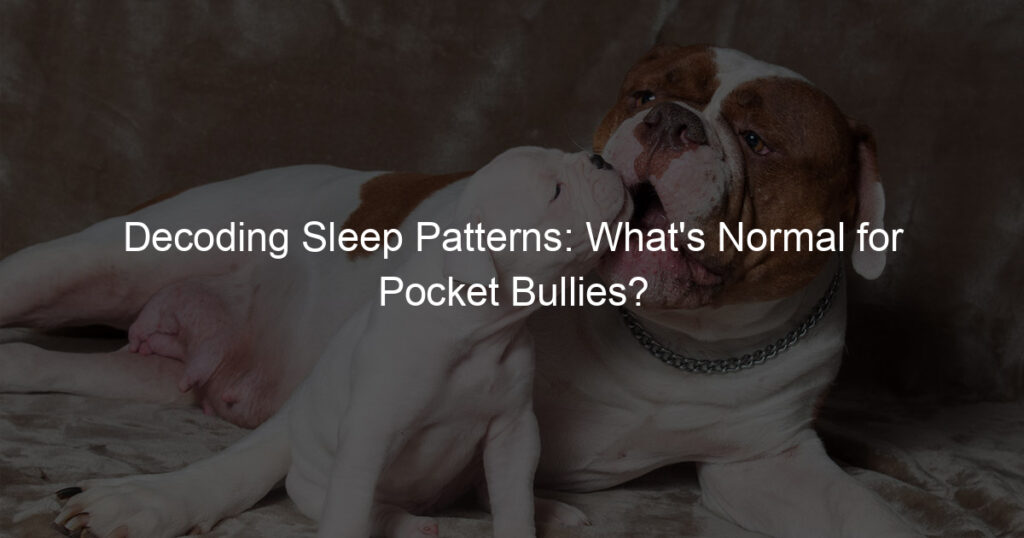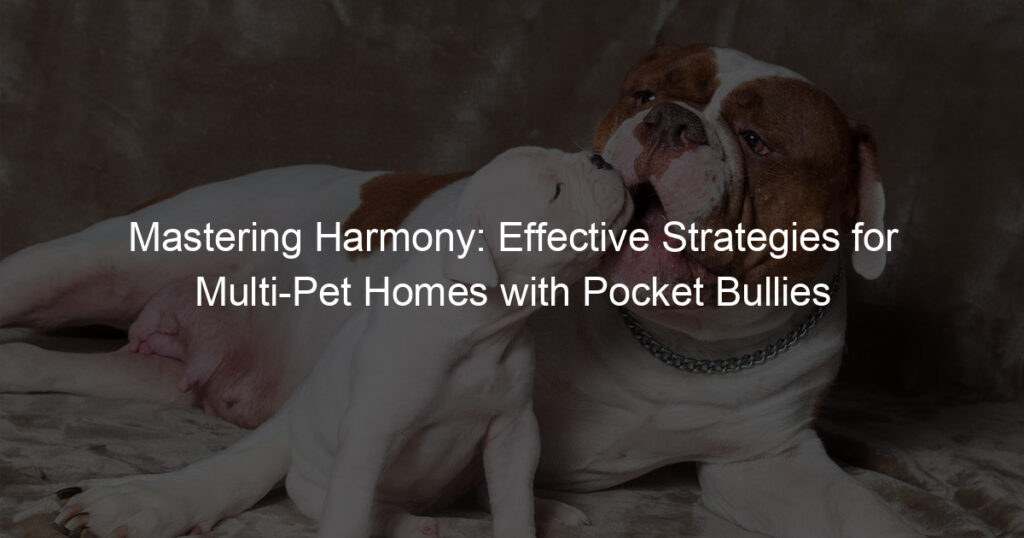
Understanding Noise Sensitivity in Pocket Bullies
Noise sensitivity is a common issue among many dog breeds, including Pocket Bullies. This condition can affect their quality of life and their relationship with their owners. In this section, we will define noise sensitivity, identify its common signs, and discuss its causes in Pocket Bullies.
- Defining Noise Sensitivity
- Common Signs of Noise Sensitivity in Pocket Bullies
- Panting and pacing around the house
- Excessive barking or whining
- Hiding or trying to escape
- Shaking or trembling
- Excessive drooling or yawning
- Causes of Noise Sensitivity in Pocket Bullies
- Genetics: Some dogs may be genetically predisposed to noise sensitivity.
- Lack of Socialization: Dogs that are not properly socialized during their early stages may develop noise sensitivity.
- Past Trauma: Dogs that have had a traumatic experience related to loud noises may develop noise sensitivity.
Noise sensitivity, also known as noise phobia, is a condition where dogs show an excessive fear or anxiety response to specific sounds. This is not a sign of bad behavior but a genuine psychological condition that needs understanding and proper handling.
Recognizing the signs of noise sensitivity in your Pocket Bully is the first step towards helping them. These signs may include:
These signs can vary from dog to dog. It’s important to note that these behaviors are not a sign of disobedience but a response to fear or anxiety.
The exact cause of noise sensitivity in Pocket Bullies is not fully understood. However, some possible causes include:
Understanding the causes can help in developing a suitable plan to manage and reduce noise sensitivity in your Pocket Bully.
Assessing Noise Sensitivity in Your Pocket Bully
Understanding if your Pocket Bully is sensitive to noise involves careful observation, consultation with a professional, and understanding their fear triggers. Here’s how you can assess noise sensitivity in your Pocket Bully.
- Observing Your Dog’s Behavior
- Consulting with a Veterinarian
- Understanding Your Dog’s Fear Triggers
Observation is the first step in assessing noise sensitivity. Watch your dog’s reaction to various sounds. Does your Pocket Bully show signs of distress when exposed to loud noises such as thunderstorms, fireworks, or even the sound of a vacuum cleaner? Signs of noise sensitivity can include shaking, hiding, excessive barking, or trying to escape. Note down these behaviors and the sounds that trigger them for future reference.
Once you’ve observed your dog’s behavior, it’s time to consult with a veterinarian. A professional can help confirm if your dog’s reactions are indeed due to noise sensitivity. They may also rule out any other health issues that could be causing similar symptoms. Remember, it’s always best to seek professional advice when it comes to your pet’s health.
Understanding your dog’s fear triggers is crucial in managing noise sensitivity. Every dog is unique, and what triggers fear in one dog may not affect another. By understanding what specific noises cause your dog distress, you can better prepare and protect your pet from these sounds. This understanding will also be beneficial when it comes to training your Pocket Bully to cope with noise sensitivity.
In conclusion, assessing noise sensitivity in your Pocket Bully involves careful observation, consulting with a veterinarian, and understanding your dog’s fear triggers. By taking these steps, you can help your pet live a happier, more comfortable life.
Helping Pocket Bullies with Noise Sensitivity
Noise sensitivity can be a significant issue for Pocket Bullies, but there are ways to help them cope. One effective method is by creating a safe space for them. This involves choosing the right location and using comforting items.
Creating a Safe Space
A safe space is a designated area where your Pocket Bully can retreat to when they are feeling overwhelmed by noise. It should be a quiet, comfortable, and secure area that they can easily access.
- Choosing the Right Location
- Using Comforting Items
Choosing the right location for your Pocket Bully’s safe space is crucial. It should be a quiet area where noise is minimal. This could be a spare room, a corner of your living room, or even a large closet. The key is to ensure that the area is away from the main sources of noise in your home. For example, it should be far from the kitchen, where appliances can be loud, or from windows where street noise can be heard.
Once you’ve chosen the right location, you can make the space more comforting by adding items that your Pocket Bully finds soothing. This could include their favorite blanket, toys, or a piece of your clothing that carries your scent. You can also add a dog bed or a crate if they find it comforting. Remember, the goal is to make this space a sanctuary for your Pocket Bully where they can feel safe and secure.
Creating a safe space for your Pocket Bully can significantly help them cope with noise sensitivity. It provides them with a refuge where they can retreat to when the noise becomes too much. By choosing the right location and using comforting items, you can make this space a haven for your Pocket Bully.
Using Distraction Techniques
When it comes to helping pocket bullies with noise sensitivity, distraction techniques can be incredibly effective. These methods aim to divert your dog’s attention away from the noise that is causing them distress. They can be particularly useful during instances when the noise is unavoidable, such as during a thunderstorm or fireworks display. Let’s explore two popular distraction techniques: interactive toys and the use of music or white noise.
- Interactive Toys
Interactive toys are a great way to keep your pocket bully engaged and distracted from any disturbing noises. These toys are designed to stimulate your dog’s mind and keep them busy. For example, puzzle toys that dispense treats when solved can be a great choice. They not only distract your dog but also reward them for their efforts, which can help reduce their anxiety.
- Music and White Noise
Another effective distraction technique is the use of music or white noise. Studies have shown that certain types of music, particularly classical music, can have a calming effect on dogs. Similarly, white noise can help mask the sound of the noise that is causing your pocket bully distress. You can easily find playlists designed for dogs on various music streaming platforms, or use a white noise machine or app.
Remember, every dog is unique and what works for one might not work for another. It may take some trial and error to find the distraction techniques that work best for your pocket bully. However, with patience and consistency, you can help your furry friend cope with their noise sensitivity.
Noise Sensitivity Training for Pocket Bullies
Noise sensitivity can be a significant issue for pocket bullies, but with the right training, they can learn to manage their reactions. One effective method is desensitization.
Desensitization
Desensitization is a process that helps your pocket bully gradually get used to noises that currently cause them stress or fear. It’s like dipping your toes in the water before you start swimming. Let’s dive into understanding this process and how to implement it.
- Understanding Desensitization
- Implementing a Desensitization Plan
- Identify the Noise: Determine which noises cause your pocket bully stress or fear.
- Start with Low Volume: Begin by playing the noise at a volume that your dog barely notices.
- Gradually Increase the Volume: Slowly turn up the volume over several days or weeks, allowing your dog to adjust to each level.
- Monitor Your Dog’s Reaction: Watch for signs of stress or fear. If your dog seems uncomfortable, turn the volume back down and proceed more slowly.
- Consistency is Key: Practice this process regularly, ideally every day, until your dog no longer reacts negatively to the noise.
Desensitization is a technique used to reduce a dog’s negative reaction to certain stimuli, in this case, noise. It involves gradually exposing your pocket bully to the noise that scares them, starting at a low level and slowly increasing the volume over time. The goal is to help your dog become comfortable with the noise at each level before moving on to the next.
Implementing a desensitization plan requires patience and consistency. Here are some steps to help you get started:
Remember, every dog is unique, and what works for one may not work for another. It’s important to be patient and adjust your plan as needed based on your dog’s reactions. With time and consistency, your pocket bully can learn to tolerate and even ignore the noises that once caused them stress.
Counter-Conditioning
Counter-conditioning is a powerful tool that can help your Pocket Bully overcome noise sensitivity. It’s all about teaching your pet a new response to a noise that previously scared them. Let’s dive into understanding counter-conditioning and how to implement a counter-conditioning plan.
- Understanding Counter-Conditioning
Counter-conditioning is a process where we change a pet’s emotional response to a particular trigger. In the case of noise sensitivity, the trigger is a loud noise. The goal is to replace the fear response with a more positive or neutral feeling.
Imagine your Pocket Bully is scared of thunder. Every time there’s a storm, they hide under the bed, shaking. With counter-conditioning, we would aim to change this response. Instead of fear, we want your pet to feel calm or even happy when they hear thunder.
How? By associating the scary noise with something they love. This could be their favorite treat, a fun game, or cuddle time with you. Over time, your Pocket Bully will start to associate the noise with these positive experiences instead of fear.
- Implementing a Counter-Conditioning Plan
Implementing a counter-conditioning plan involves patience and consistency. Here are some steps to follow:
- Identify the trigger: The first step is to identify the noise that scares your Pocket Bully. It could be thunder, fireworks, or even the sound of a vacuum cleaner.
- Choose a positive association: Next, decide on a positive experience you can use to counter the fear. This could be a tasty treat, a favorite toy, or a special activity.
- Start the training: Start the training during a quiet time when the scary noise is not present. Give your pet the treat or start the fun activity. After a few minutes, introduce the noise at a very low volume. If your pet stays calm, reward them with more treats or playtime.
- Gradually increase the noise level: Over time, gradually increase the volume of the noise. Always reward your pet for staying calm. If they show signs of fear, go back to a lower volume and try again later.
Remember, counter-conditioning takes time and patience. But with consistency, your Pocket Bully can learn to stay calm and happy, even in the face of previously scary noises.
Professional Help for Noise Sensitivity in Pocket Bullies
If your Pocket Bully is struggling with noise sensitivity, it may be time to seek professional help. This can be a daunting process, but with the right information, you can find the help your furry friend needs.
- When to Seek Professional Help
- Choosing the Right Professional
- What to Expect from Professional Training
It’s important to recognize when your Pocket Bully’s noise sensitivity is beyond what you can manage at home. If your dog is showing signs of extreme distress, such as excessive barking, shaking, or hiding, it may be time to consult a professional. Additionally, if your attempts at training and desensitization aren’t showing results, a professional can provide more specialized techniques.
Not all professionals are created equal. Look for a trainer or behaviorist who has experience with noise sensitivity in dogs, specifically Pocket Bullies. Ask for references and check their credentials. It’s also important to choose someone who uses positive reinforcement methods, as these are the most effective and humane.
Professional training for noise sensitivity typically involves a combination of desensitization and counter-conditioning. Desensitization involves gradually exposing your dog to the noise in a controlled environment, while counter-conditioning involves changing your dog’s emotional response to the noise. The professional will likely work with you and your dog over several sessions, and will provide you with techniques to practice at home.
Remember, it’s okay to seek help if you’re feeling overwhelmed. Your Pocket Bully’s well-being is the most important thing, and a professional can provide the help you need to manage your dog’s noise sensitivity.
Reducing Noise Sensitivity in Pocket Bullies: Key Takeaways
In this article, we’ve explored the topic of noise sensitivity in Pocket Bullies. We’ve learned that it’s a common issue that can cause significant distress for these small but mighty dogs. Here are the key takeaways from our discussion:
- Understanding Your Dog’s Fear: Noise sensitivity in Pocket Bullies is often rooted in fear. It’s important to understand that your dog isn’t acting out – they’re genuinely scared. Recognizing this can help you approach the situation with empathy and patience.
- Creating a Safe and Comforting Environment: One of the best ways to help your Pocket Bully cope with noise sensitivity is to create a safe and comforting environment. This might include a quiet room with soft lighting, comfortable bedding, and familiar objects. You can also use calming aids like white noise machines or calming sprays.
- Implementing Training Techniques: Training can be an effective way to help your Pocket Bully overcome noise sensitivity. Techniques such as desensitization and counter-conditioning can help your dog associate scary noises with positive experiences. Remember, it’s important to go slow and never force your dog to face their fears all at once.
- Seeking Professional Help When Necessary: If your Pocket Bully’s noise sensitivity is severe, it might be time to seek professional help. A professional dog trainer or a veterinary behaviorist can provide specialized techniques and strategies to help your dog cope with their fear.
In conclusion, noise sensitivity in Pocket Bullies is a manageable issue. With understanding, patience, and the right approach, you can help your furry friend live a happier, less stressful life.
